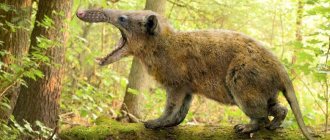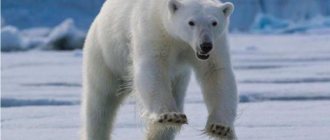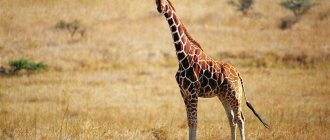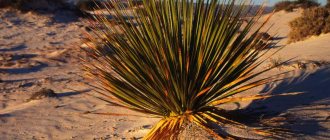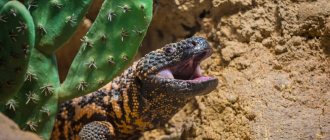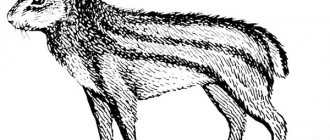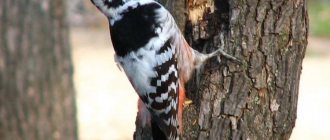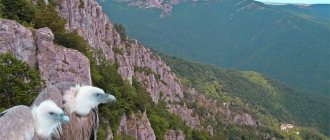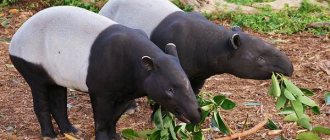It’s not for nothing that there was a saying in Rus': “Living near a forest means you won’t go hungry.” Forests still serve as a source of food, energy, industrial raw materials, and building materials for people. Russia is rich in forests, their area is 8.8 million km². These are mainly temperate forests, which are called mixed and deciduous. They consist of different trees that form several tiers.
They have incredible value for life on the planet. Forests serve as carbon storage and play an important role in combating climate change. They act as a watershed and are the source of many raw materials on which people depend. The forest biome probably supports the greatest biodiversity.
For example, a small area of tropical forest can be home to millions of insects, birds, animals and plants. There are three main types of forest that make up the forest biome. These are tropical forests, temperate forests, and boreal forests (also called taiga).
Elk
Forest animals feel confident in their familiar habitat. They are comfortable in the forest, despite the fact that there are dangers here, but each species has adapted to defend itself and hide.
The crown jewel of the forest community is the elk, which belongs to the Deer family. Some specimens reach a length of up to three and a half meters and a height of up to two meters. The weight of such an animal can reach 500 kilograms. Agree, these are impressive parameters. It is very interesting to watch such a giant moving silently through the forest.
He is very strong and, oddly enough, swims and dives remarkably well. In addition, he has a keen ear and good instincts. Imagine that a moose can jump over a four-meter hole or a two-meter obstacle without a run. Not every animal can do this.
It lives exclusively in forests. In other areas it can only be found during spring migrations. At such times you can encounter him in the fields, sometimes he even enters villages. Elk feed on shoots of pine, rowan, aspen, buckthorn, bird cherry, and willow. It also eats herbaceous plants, mushrooms, moss, and berries. Forest animals are forced to look for food in winter. And they don’t always manage to find it so easily. Sometimes moose cause great harm by eating young pine trees and forest plantations. This only happens in winter, when food is very scarce, and a decent number of individuals are concentrated in a relatively small area.
However, forest districts are trying to carry out biotechnical measures to create comfortable and satisfying living conditions for these wonderful animals.
Forest flora
The main plants of the forest are, of course, trees. Conifers grow in the taiga. These are spruce, pine, fir, larch.
The most interesting vegetation is presented in the mixed forest zone. Deciduous and coniferous trees form a symbiosis. Spruce, pine, oak, poplar, willow, birch, chestnut, cedar, linden, maple, beech, and hornbeam trees grow here.
Among the shrubs, it is worth highlighting hazel, juniper, bird cherry, rowan, hawthorn, and viburnum.
And in the lowest tier there are shade-loving herbaceous plantings, mushrooms, and mosses. Some plants in mixed forests shed their leaves in the fall.
To the south, the forest becomes completely broad-leaved, and no conifers are found in it. Oak, alder, linden, wild apple, and chestnut grow here. Particular attention should be paid to herbs, some of them have healing properties. Oregano, horsetail, impatiens, marigold, fireweed, Ivan-da-Marya, and swimsuit grow in the forest.
Forest animal bear
The brown bear is the most famous forest inhabitant. He is an indispensable hero of most folk tales. Moreover, he always acts as a good character. However, it should be noted that bears are predatory animals of the forest.
They can rightfully be called the masters of the forest. The bear has a powerful body, a fairly large head, but small eyes and ears. He has a hump on his withers, which is nothing more than muscles that give him the ability to deliver very strong blows. The bear's tail is very small, about twenty centimeters. He is practically invisible in his thick, shaggy fur. The color of the animal varies from light brown to almost black. Of course, the most typical color is brown.
The animal has very powerful paws. Each of them has five fingers. The claws on the animal's paws reach ten centimeters in length.
About forest flowers
It's beautiful in the forest in spring. Many people like to go there and admire the snowdrops. Later, a variety of other forest flowers, medicinal and poisonous herbs appear.
Interesting facts about plants: in the forest area, people not only collect bouquets of flowers, but also replant some of them in gardens. It is worth remembering that such plants require familiar climatic conditions: it is best to plant them in the shade of bushes and trees.
Surprisingly, many plants from the forest over time turned into decoration of every garden. The ancestors of the rose, which we all know very well, are forest representatives of the rosehip genus.
Brown bear habitat
These majestic forest animals previously lived over vast territories. Now their range has narrowed significantly. Currently, they are found in Finland and Scandinavia, sometimes in the forests of Central Europe and, of course, in the taiga and tundra in Russia.
The size and body weight of bears depend entirely on their habitat. The weight of animals living in Russia does not exceed 120 kilograms. However, Far Eastern bears are much larger. Their weight reaches 750 kilograms.
Their favorite habitat is impenetrable forest areas littered with windbreaks or places with dense thickets of bushes and trees. However, they also love rough terrain, and therefore can be found in the tundra and high mountain forests.
Types of forests
Before studying forest flora and fauna, you need to understand what types of forests exist in nature. Their classification depends on their geographical location:
- coniferous or northern forests;
- mixed forests;
- deciduous forests.
Scheme of forest types
The Forest Code of the Russian Federation indicates the types of forest uses. Based on Article 25, it is permitted to harvest wood and resin, collect medicinal herbs and food forest resources, conduct agriculture, carry out recreational and scientific research activities, and grow plants.
Northern forests
From the westernmost borders of the Russian Federation to the Verkhoyansk Range there is a zone of coniferous forests or taiga. They occupy at least 70% of all forest areas in the country. There are always low temperatures and high humidity. The basis of the coniferous forest is spruce, pine, fir and larch. The soil here is frozen most of the time. The lack of liquid water does not allow juices to circulate throughout the plants. Consequently, the foliage has the appearance of needles impregnated with resinous substances. They protect against severe frosts and drying out. Larch is the only tree in coniferous forests that sheds its needles.
The harsh Russian winter is characterized by mixed types of forests, consisting of light coniferous and dark coniferous species. Cold climates are good for evergreen trees. Only with the onset of favorable weather conditions can they begin photosynthesis. Another distinctive feature of the taiga is the almost complete absence of undergrowth.
Mixed forests
After the taiga, the mixed forest zone begins. The name itself says that it is characterized by both deciduous and coniferous species, and other species should be at least 5%. Climatic conditions are characterized by warm summers and non-frosting winters, lasting 3.5-4 months. Swift rivers provide forests with moisture, and sedimentary rocks provide good conditions for the formation of lakes and swamps.
Unlike conifers, mixed forests occupy small areas. In the south they gradually turn into broad-leaved ones, where there is not a single coniferous species. The northern edge of Russia's mixed forests runs through St. Petersburg. Such forests grow in Scandinavia, Canada, the USA, and in the center and east of Europe.
The best conditions for mixed forests are created in a temperate continental climate. They grow in river valleys where there is no icy wind. Fallen leaves, combined with moderate humidity, saturate the soil of mixed forests with humus. There are clearly defined tiers.
Deciduous forests
All woody vegetation of the deciduous forest zone has wide and flat leaf blades, the main function of which is photosynthesis. Forests are common in the temperate climate of the Northern Hemisphere. There is a clear change of seasons - winter, spring, summer, autumn. With the arrival of cold weather, trees and shrubs of deciduous forests shed their leaves, the trees become “naked”.
The most common species are aspen, apple, willow, maple, and oak. There are many birch trees in Russia; they grow for about 150 years and are unpretentious to the conditions. Forests have clearly defined tiers - trees of different heights, shrubs, grasses. Moreover, there are several times more varieties of the latter than the trees themselves.
Deciduous forests are divided into:
- Broad-leaved - grow in humid and moderately humid climate zones. For such forests, it is very important to distribute the temperature evenly throughout the year.
- Small-leaved forests are the lightest deciduous forest in Russia. Its small oblong leaves do not block the passage of sunlight. The massifs in the Far East and West of Siberia are represented. Their soils are more fertile and their vegetation diversity is wider. Small-leaved species are unpretentious; they grow in areas of forest fires and in industrial logging areas.
What does a predator eat?
It must be said that the bear eats almost everything that can be eaten. Most of his diet is plant foods: herbs, mushrooms, berries, nuts. When an animal does not have enough food, it can eat insects and larvae, rodents, reptiles and even carrion. Large representatives can afford to hunt ungulates. It is only at first glance that these forest animals seem very clumsy. In fact, when chasing prey, bears show miracles of dexterity. They are capable of reaching speeds of up to 55 kilometers per hour.
Bears also love to eat fish. By autumn they eat off and gain about twenty percent of their weight.
Jerzy
Most adults and children love hedgehogs. The behavioral characteristics of hedgehogs can be classified as interesting facts about animals. Hedgehogs feel great in the forest zone. But many are mistaken in the harmlessness of these small forest animals.
Hedgehogs are dangerous carriers of infection due to ticks and other parasites.
In books and cartoons, hedgehogs carry apples and mushrooms on needles. In fact, the hedgehog is a predatory animal. Their main food is small rodents and beetles. But it is true that when in danger, hedgehogs curl up into balls. Needles are good protection.
These animals are very agile. They swim well, can jump and run up to 2-3 meters per second. They are nocturnal. Their homes are located next to each other, but hedgehogs do not gather in company.
Hibernation of bears
However, the life of forest animals changes very much in winter. Bears spend half of the year in their den-den, hibernating. They choose a place for their home in the most inaccessible places. As a rule, they make their winter rookery under the huge roots of broken spruce trees, in rock crevices, and in rubble after windbreaks. They line the inside of their house with dry moss and grass. Bears sleep quite lightly. If you disturb him, he may well wake up, and then be forced to look for a new cozy place to sleep.
When there are very hungry years and the bear cannot gain enough fat reserves, it does not fall asleep. The animal simply wanders in search of food. Such a bear is called a connecting rod. During this period, he becomes very aggressive and is capable of attacking even a person.
The mating season for bears is in May and June. It is usually accompanied by strong roaring and fights between competing males.
After mating, a female bear gives birth to cubs after about six months. They are born in a den. As a rule, two babies are born weighing up to half a kilogram. By the time the couple leaves the den, the offspring have reached the size of a dog and are already beginning to feed with the adults.
The cubs live with their mother for a couple of years. They reach sexual maturity at three to four years. In general, bears live in the wild for up to thirty years.
Japanese green pigeon
This amazing bird differs from the ordinary pigeon with its bright yellow-green color. The pigeon inhabits mixed and deciduous forests in the area of Sakhalin Island. The main condition for the habitat of the Japanese green pigeon is the presence of cherries, elderberries and bird cherry trees in the forest, the fruits of which it is partial to.
The green dove is a rare species, so very little is known about it. Scientists have learned that this is a monogamous bird that weaves nests high in trees, where partners take turns incubating eggs for 20 days. After this, tiny chicks covered with down are born, which will become independent only after 5 weeks. Although, unfortunately, green pigeons in Russia are rarely seen in pairs, much less in flocks, they are noticed mostly alone.
Wolf
We always associate forest animals with predators. One of their representatives is the wolf. There are a huge number of them in our country. For a long time, people have been actively fighting wolves, since they cause significant damage to households.
It is widely believed that the wolf is a forest animal. However, this is not quite true. There are many of them living in the tundra, forest-steppes and steppes. They prefer open spaces. And people are forcing them to go into the forests, actively fighting them.
Outwardly, the wolf looks like a large large dog. He has a powerful physique. The length of its body reaches up to 1.5 meters. Weight ranges from 30 to 45 kilograms. Females are generally smaller than males.
Wolves have strong and resilient paws. They are long distance runners. In general, this is a highly organized animal and also very smart. Looking at each other, the wolves exchange information.
This animal has well-developed hearing, excellent sense of smell and vision. The wolf receives all information about the surrounding world through its sense of smell. He is able to distinguish the tracks of forest animals by smell many hours after they left them. In general, it is difficult for us to imagine the variety of smells that a wolf can distinguish.
Forest fauna
All forest animals are part of a single natural complex. Each component of this complex takes its place and performs its assigned functions. It is in the forest that about half of all existing wild animals on the planet live. Many of them are tied to vertical tiers or specific forest vegetation. The variety and number of animals in the forest zone directly depends on the quality and quantity of vegetation.
The richest fauna is represented in the tropical rainforest zone. Herbivores live in the crowns of trees. In addition, predators have also learned to climb trees. Primates, sloths, porcupines, chameleons, and iguanas live here. The tropics have a huge number of birds and insects. As you move away from the equator, the diversity of species decreases noticeably.
The main animals of mixed forests are fox, squirrel, hare, beaver, wolf, marten, wild boar, mole, bear, deer, elk, and roe deer. Taiga is famous for wolverine, sable, musk deer, and white hare.
Plants and animals of forests are closely interconnected. Plants are a source of food and shelter, and animals contribute to their reproduction.
Communication between the inhabitants of the forest
All groups of forest inhabitants are closely interconnected:
- Food chains - some animals are predators, some are their prey. But no matter how strong and brave the animal is, it will still die sooner or later and become food for microorganisms and insects.
- Trees, grasses and shrubs provide natural shelter from the enemy and bad weather. They also form the basis of the diet in the life of forest inhabitants.
- Animals perform a transport function; they carry seeds and fruits of plants and expand their growing area.
- Small rodents and insects dig holes and labyrinths in the ground, which leads to oxygen enrichment of the soil.
- Bacteria and fungi take part in the decomposition of plant and animal remains. They process them into mineral fertilizers, which are simply necessary for plant nutrition.
Habits of wolves
Wolves are very strong and hardy animals. They reach speeds of up to 60 kilometers in pursuit of prey. And in a throw this value increases to 80.
In summer, wolves live in pairs and raise their offspring strictly within their own territory. By winter, young individuals, together with older ones, gather in groups and lead a wandering lifestyle. Wolves, like all forest animals, change their lifestyle in winter.
Usually a pack consists of ten wolves, which are representatives of the same family. Sometimes several flocks can unite into one larger one. This is possible in severe snowy times or when there is very large prey.
What is the Red Book
In order to make it possible to take measures to preserve populations of rare and endangered animals, the international Red Book was created in 1963, and in 2001 the Red Book of Russia was published. It included a description of 231 species of animals inhabiting the territory of the Russian Federation and requiring protective measures.
The green pages tell us that thanks to human efforts, the numbers of the species, previously included in the International Red Book, have stabilized. Animals of forest zones also appear on these lists. True, unfortunately, out of 305 species of endangered mammals, only 7 have stabilized their numbers, and out of 258 birds - only 4.
What do wolves eat?
Since the wolf is a predator, meat is the basis of its diet. Although sometimes an animal can try plant foods. The wolf hunts absolutely any animal that is within his power. If he has enough game, he will not stop looking into human settlements. Wolves are very intelligent and understand the full extent of the risk.
In the forest, this animal hunts for almost all inhabitants, from elk to chipmunk and vole. Of course, its favorite prey, depending on the habitat, is wapiti, reindeer, and roe deer. However, the wolf will not disdain a fox, a raccoon, a rat, a ferret, a pig, or a hare. The hunting habits of wolves are varied. They can wait for their prey in ambush, or they can drive it for a long time. And their collective hunt is generally a complex, well-coordinated mechanism where everyone understands each other without words.
Very prudently, they drive their prey into the water in a flock. The wolf is a large predator, but it can catch fish, frogs, mice, and also likes to destroy bird nests.
But it is not always only forest animals and birds that become the prey of predators. In populated areas there is not enough game, and therefore in the harsh winter months, when it becomes very difficult to survive, wolves stay closer to villages and begin to plunder. Their prey can be sheep, dogs, pigs, horses, cows, and goose. In general, any living creature that a predator can reach. Even one individual can cause a lot of damage in one night.
Fish owl
The most unusual and largest species of owls, and it is also endangered. Fish eagle owls are caught by poachers, and the birds themselves often end up in traps.
Birds live on the shores of the Far East in tree hollows that are not far from water areas.
fish owl
Eagle owls look out for fish, sitting on a stone or branch, so that at the right moment they dive into the water and snatch the prey with their tenacious claws. But birds catch sedentary prey by completely immersing themselves in the water, probing the bottom with their paws.
Water tourism is popular on Far Eastern rivers. Because of this, fish eagle owls are restless, their numbers are decreasing, and they are in danger of extinction.
Fox
Forest animals for children are, rather, fairy-tale characters. And the fox is generally the heroine of many children's fairy tales. However, as a fairy-tale person, she is endowed with those features that are inherent in her in real life. The fox is both beautiful and cunning. She has a long fluffy tail and a cunning narrow muzzle and small eyes. This predator is really slender and graceful; in size it is comparable to a small dog. Weighs from six to ten kilograms.
Since childhood, we are accustomed to calling the fox red. And rightly so. It’s just that in life her belly is white or grayish. The back and sides are colored differently: from light gray to bright red. As a rule, northern foxes have bright colors. And the more faded ones are those that live in the forest-steppe. Silver fox fur is considered the most beautiful and expensive. Such foxes have long been bred on special farms, since they are extremely rare in the wild. And among people, their fur is especially popular for its beauty.
In summer, the animal looks a little awkward due to the fact that the fur becomes short and stiff during this period. But by autumn the fox grows a beautiful winter coat. The predator sheds only once a year - in the spring.
Mystery of the forest zone
Poland can boast of interesting facts. People have been talking about the forest area near the town of Gryfino for a long time. The “Crooked” or “Drunken” Forest is a real mystery of nature.
About 400 pine trees with curved trunks towards the north. This spectacle looks interesting and frightening.
Some claim that a strong wind worked on the trees, others say that they were planted on purpose. Both statements are just guesses.
Cosmobiologists believe that the bending of the trunks occurred due to negative energy. In their opinion, you should stay away from this forest.
Habits of a sly fox
The fox is found not only in the forest, but also in the tundra, mountains, steppes, swamps, and even near human habitation. She is great at adapting to any conditions, but still loves more open spaces. She doesn't like the remote taiga.
In life, as in fairy tales, the fox is very fast and agile. She runs very quickly and easily catches insects flying by. As a rule, she moves at a leisurely trot. Periodically stops, looks around, looks around. Lisa is very careful. When it sneaks up on prey, it crawls quietly on its belly, almost merging with the ground. But he runs away from pursuit with large and sharp leaps, skillfully confusing his tracks.
You can see downright fairy-tale episodes in fox behavior. People invented them for a reason. All stories are taken from real life. Foxes are truly cunning predators who approach hunting wisely. Rather, they take prey not by force, but by seduction. No other animal is named by its patronymic. And the fox's name is Patrikeevna. Why?
Once upon a time there was such a prince named Patrikey. He became famous for his cunning and resourcefulness. Since then, the very name Patrikey has been associated with cunning people. The fox has long been known among the people as a cheat, which is why it was dubbed Patrikeevna.
Reasons for the disappearance of animals
This problem is relevant for many countries around the world. The disappearance of many animal species from our planet without a trace is of great concern to conservationists. The main reason for this phenomenon is considered to be a disruption of the natural balance as a result of environmental pollution, which has a detrimental effect on representatives of the animal world.
A person’s consumer attitude towards nature also plays a big role. Poaching has led to a significant reduction in the population of many animal species, and some of them have disappeared forever. Our country is no exception. Animals included in the Red Book of Russia are also on the verge of extinction (a description of the rarest of them is given in this article).
Who do foxes hunt?
Foxes are very active animals. In winter, its tangled tracks are clearly visible in the snow. You can immediately see where the cheat was hunting. It is generally accepted that foxes feed on hares. But this is a big misconception. She is not able to catch up with such fast prey. Of course, if she stumbles upon defenseless bunnies somewhere, she will certainly take advantage of the opportunity. That’s why hares are a very rare dish in her diet. She just can't keep up with them.
Foxes feed on a variety of insects, birds and animals. But the basis of their menu is rodents. Predators are excellent at exterminating voles. In addition, they know how to fish in shallow waters. Sometimes animals feast on berries.
The shrew is an animal that keeps many secrets
To some extent, the reduction in numbers was also helped by the shrew’s ability to bear only one litter in the summer. By the way, scientists have not been able to determine the number of cubs in it. It is only known that the number of embryos in a female is only 2-4 individuals, and their resorption is high. Scientists were also unable to determine the sex ratio because they were unable to catch a single adult male.
These amazing forest animals of Russia feed mainly on earthworms, which make up 95% of their diet. To get food, they are able to burrow even into very dense soil. The number of species today is only 42 individuals.
Hares
The forest life of animals is very interesting to study. All representatives of the animal world are very different, some run away, others hunt. Previously we looked at some predators. Now let's talk about the brightest representative of the forests. Of course, about the hare.
Hares, as in fairy tales, have long ears and short tails. Their hind legs are much longer and more powerful than their front legs. In winter, it is clearly visible in the snow that the prints of the hind paws are ahead of the front ones. This is caused by the fact that they carry them forward while running.
These animals feed on food that does not attract others at all, for example, bark, young shoots and branches, and grass.
Many fairy tales have been written about forest animals, but the favorite hero has always been the hare. Even in life, when escaping from pursuit, he is cunning and tries to confuse his tracks, jumping first in one direction, then in the other, just as in children’s stories. He is capable of running at a speed of 50 kilometers per hour. Not every predator can keep up with such fast prey. In general, hares have many ways in their arsenal to evade persecution. These forest inhabitants are so cunning. Animals know how to both run away and defend themselves, and in each case they use the most optimal tactics - their sense of smell is so developed.
But it is not so much their cunning that saves the hares as they win with their numbers. They have four to five litters annually. Each of which can contain from two to five bunnies.
The most famous hares are brown and white hares. They weigh up to seven and a half kilograms and reach a length of 70 centimeters. Their main difference is the color of the fur. Browns do not change their color in winter. But in summer it is much more difficult to distinguish these varieties.
In general, hares tend to live a sedentary life. Of course, they gallop across fields and meadows, going quite long distances. But then they return to their habitat. Very rarely they can migrate. This only happens in particularly cold and snowy winters.
The bison is the heaviest animal in Europe
Once you see a bison, it’s hard to forget it. A huge bull with a rectangular head, a hanging beard, a noticeable hump on his back and strong legs makes an intimidating impression. He has a wide, powerful chest and small, sharp, upward-curved horns.
The animal spends almost the entire summer day lying down languidly, going to pasture only in the evening. By the way, the bison needs to eat at least 32 kg of food, the basis of which is young shoots, grass and leaves.
During the mating period, males vigilantly guard their territory and do not like strangers. In such situations, you can see how dexterous and agile these forest animals can be, capable of jumping 3 m in length and easily overcoming obstacles up to 2 m high.
Fighting competitions between males are an amazing spectacle. Intimidating poses, loud sounds - all this should impress the female spectator. The winner will take advantage of her favor, and after 9 months she will give birth to a calf, which she will not stop feeding even after 5 months.
Who else lives in the forest?
We have listed only the most famous animals, since it is difficult to pay attention to all forest inhabitants within the scope of this article. There are actually a lot of them: wild boars, badgers, hedgehogs, moles, mice, squirrels, chipmunks, sables, martens, raccoons, deer, roe deer, lynxes... As they say, from young to old. They are all very different and interesting. In addition, it would be unfair not to mention birds, which also live quite a lot in our forests.
Giant shrew
This is the largest representative of the Insectivorous order, a rare endemic species of the Shrew family, the number of which is steadily declining. The shrew, which is similar in appearance to a vole, has special features - “giant” sizes (up to 10 cm), a pointed muzzle elongated into a movable proboscis, and tiny ears.
Shrews are forest animals that live in the southern part of the Primorsky Territory, preferring broad-leaved or coniferous-deciduous forests, not affected by logging and fires, located in river valleys. This became the main problem for the animal, since the reduction in the number of such places led it to extinction.
